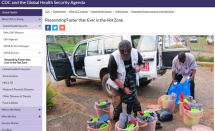Responding Faster than Ever in the Hot Zone
Uganda is considered a “hot zone” for infectious diseases. Uganda is particularly vulnerable to epidemics because of its unique location near the Congo Basin; its close connection with other countries; the risk from natural disasters; and the ever-present threat of evolving pathogens or antimicrobial resistance.
Without the ability to quickly respond to threats, a local outbreak might quickly spiral into a global health crisis. Deadly outbreaks in Uganda have included viral hemorrhagic fevers (Ebola, Marburg, yellow fever, Rift Valley fever, and Crimean-Congo hemorrhagic fever), cholera, meningitis, plague, and anthrax, among others. Newly emerging viruses have been discovered in Uganda, and the threat remains for re-emergence of pathogens like West Nile virus and Zika. In 2017, Uganda saw its first cases of highly pathogenic avian flu in migratory birds from Europe.
With support from CDC and partners through the Global Health Security Agenda, Uganda is responding faster than ever to contain outbreaks at the source. The country’s national public health emergency operations center (PHEOC) coordinates strong surveillance and response systems that work hand-in-hand to tackle emergencies, including:w?
- Multi-level surveillance systems which watch for alerts and monitor information in real-time
- A strong and efficient in-country laboratory network which accurately identifies threats within hours
- A national system gets samples to labs from anywhere in the country in 1-2 days
- A trained workforce, including a National Rapid Response Team and FETP-trained disease detectives, which can deploy quickly anywhere in the country
- A National Task Force which stands ready to take direct action
- Collaboration and partnership with national and international stakeholders which builds capacity and ensures efficient use of resources
The important work being done in Uganda has dramatically reduced the time it takes to detect and respond to outbreaks. While it took over 40 days to confirm a 2010 yellow fever outbreak through outside laboratories, global health security improvements enabled Uganda to detect and confirm a 2016 outbreak in-country in only 10 days. Today, the country responds even faster – usually within 1-2 days.
In November 2017, Uganda staged a rapid and effective response when three deadly cases of Marburg Virus Disease were reported in Eastern Uganda. CDC Uganda assisted with tracing, monitoring, and testing of 297 people in Kween and Kapchorwa Districts who had been in contact with sick patients. One suspected case traveled across the border into Kenya, raising additional concerns about the virus spreading; CDC Kenya supported emergency preparedness activities to prevent a potential outbreak there.
Source: US Centers for Disease Control and Prevention
Date of Publication: March 25, 2019
SIMILIAR RESOURCES
Tools
Examples
- Basic Psychosocial Skills: A Guide for COVID-19 Responders
- Responding to Coronavirus: Resources and Support
- WHO Pregnancy Management in the Context of Zika Virus
- Pandemic Fatigue Reinvigorating the Public to Prevent COVID-19
- COVID-19 Vaccination Communication Toolkit
- COVID-19 Vaccination Communication
- Talking to Children about Illness and Death of a Loved One during the COVID-19 Pandemic
- Dengue Clinical Case Management Online Course
- Zika and Pregnancy: Questions and Answers
- Anti-Virus: The Covid-19 FAQ

